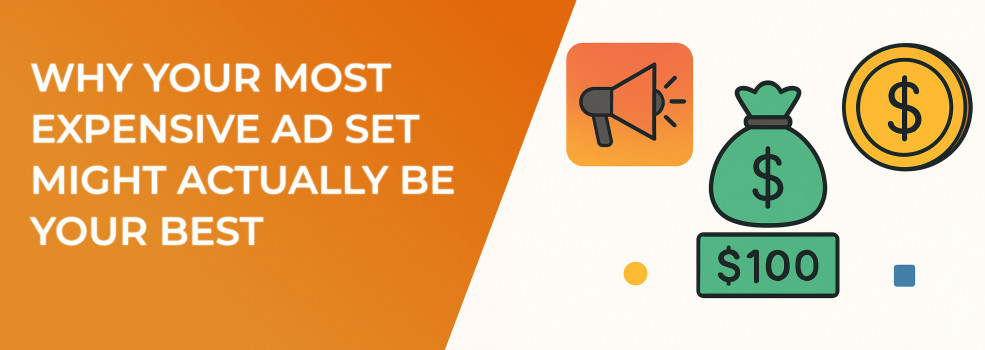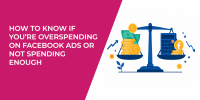High Price ≠ Low Performance
Marketers often pull the plug the moment a Facebook ads CPM or average click-through rate on Facebook ads climbs. That reflex can leave serious money on the table. Before you tighten budgets, remind yourself why the auction is pricing you higher in the first place.
Below is a quick rundown of the most common reasons a cost spike can be a positive signal. Read through the list, then compare it to your own data.
-
You are earning premium placement because your creative is winning more ad impressions Facebook than competitors.
-
The algorithm predicts stronger downstream actions such as purchases, sign-ups, or an improved Facebook ads conversion rate.
-
A broader, higher-value audience segment has opened up, driving up cost per 1,000 impressions Facebook but also long-term revenue potential.
Quick check: Before pausing an “expensive” set, pull its Facebook ads ROAS and cost per acquisition Facebook ads. If those numbers stay on target, keep it live. If you want to go deeper than surface-level metrics, our walkthrough on how to analyze Facebook ad performance beyond CTR and CPC shows which numbers truly predict profit.
Sometimes the most expensive click pays off best.
Remember that price signals quality. Your job is to verify that quality with real conversion metrics, not gut feelings.
Auction Dynamics Reward Momentum
The Facebook pacing engine loves consistency. When you slam the brakes on a winning set, the system loses the fresh feedback loops that come from steady delivery and updated Facebook pixel events. Maintaining momentum—especially with an advantage campaign budget—keeps the learning phase short and auction efficiency high.
Before the next set of practical tips, reflect on your own recent adjustments. Did you cut spend right after a spike? If so, consider restoring it and letting the algorithm gather enough data to stabilize costs.
Pro tip: Switching to campaign budget optimization lets Facebook funnel dollars into whichever ad set is hottest in real time, even if it looks pricey at first glance.
After testing CBO in dozens of accounts, our team has found that a formerly “overpriced” set often earns the lion’s share of budget and still delivers the best Facebook ads ROAS once learning finishes. For step-by-step tactics that keep momentum without blowing budget, see How to Finish the Facebook Learning Phase Quickly.
Why You Sometimes Want a High CPC
Here is a counter-intuitive truth: a soaring optimize Facebook ads CPC often points to a premium, late-funnel audience. These users cost more because they convert more often and at higher cart values.
Before we dive into tactics, picture your sales team closing a big enterprise client. The acquisition cost is higher, yet the lifetime value dwarfs that of five smaller deals. The same dynamic plays out inside the ad auction. Need a refresher on audience basics? Check out Facebook Ad Targeting 101: How to Reach the Right Audience before you expand bids.
When you see a CPC jump, do not panic. Instead, benchmark it against order value, subscription length, and other meaningful profit metrics. If those numbers outpace the extra spend, the campaign is in a healthy place.
Diagnosing a Bad Expensive Set
Sometimes a high price tag really does hide trouble. In the next table you will find three red flags to watch for, along with quick fixes. Read it slowly, match symptoms to your own ad sets, and jot down any ideas that surface.
Give yourself a moment to digest that information. If the symptoms scream “creative fatigue,” follow the playbook in Ad Fatigue on Facebook: How to Spot It Early and Fix It Fast. If you spotted a match in your dashboard, schedule fifteen minutes today to implement the fix. Small changes here can rescue thousands in wasted budget.
Optimization Without Over-Cutting
You now know when to ride out high costs and when to intervene. The list below outlines four reliable levers that lower price without killing performance. Read each point, decide which one fits your situation, and commit to testing it this week.
-
Leverage Better Signals, Not Guesswork
Import purchase events through your Facebook pixel every day so the algorithm keeps rewarding top segments. Even a few hours of delay can degrade learning. -
Embrace Broader Lookalikes
A three-to-five-percent lookalike audience Facebook can unlock scale without spiking costs and often beats super-narrow “cheaper” sets on overall revenue. -
Experiment with Bidding
Test a switch from cost-cap to highest-value. Many advertisers see volume hold steady while price inches lower, leading to an improved Facebook ads conversion rate. For a bigger-picture view of budget allocation, read The Science of Scaling Facebook Ads Without Killing Performance. -
Seek Outside Perspective
Follow Facebook ads advice from peers, but always test on a small budget first. What works in one vertical does not always translate directly.
Pause for reflection once you have selected your lever. A planned test schedule will always beat a frantic scramble to plug budget leaks.
The Bottom Line
Your most expensive ad set can be the sharpest growth lever in your account. When you judge success by conversion rate, ROAS, and profitable Facebook ad spend, cost by itself becomes a vanity metric. Trust the data, stay patient through learning phases, and let performance, not fear, guide your next budget decision.

